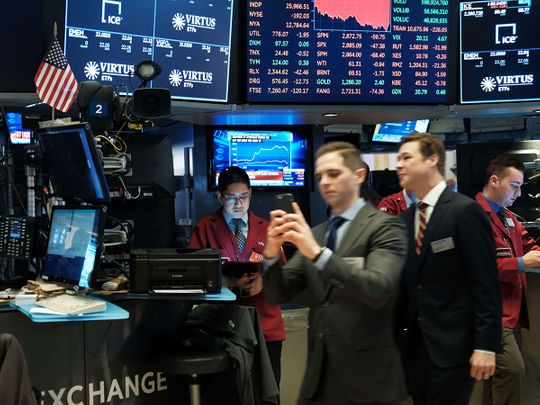
The market has grown accustomed to regarding President Donald Trump’s tweets as background noise, but the one over the weekend predicting a massive increase in tariffs on China was an exception. Then came Tuesday, and a post on the WeChat account affiliated with the People’s Daily, which is the flagship newspaper of the Chinese Communist Party.
Surely with the approval of authorities, it warned the US: “Don’t even think about it.”
This sounded more like the language Trump might have expected from one of his building contractors, and was a new element for the market to digest. We’re not accustomed to politicians replying in kind to Trump, and it is a disturbing development.
Therefore it should not come as any surprise that world markets had another torrid day. It plainly makes sense to say that the risks of a true conflagration have risen, and that means the price of risk assets should come down. But in the greater scheme of things, it is surprising and perhaps reassuring that the market didn’t fall a lot more.
On sensible valuation measures, the S&P 500 Index entered this week looking very stretched. We don’t need to enter into the territory of cyclically adjusted multiples to prove the point.
The price-to-book and price-to-sales multiples for the S&P 500 were close to the highs they set in last year’s two peaks, and were as high as they have been since early 2002 (in the case of the book ratio) or 1999 (in the case of the sales ratio).
They achieved this with trade uncertainty unresolved. So it seems fair to say that the market was perfectly set up to step on a rake if geopolitical uncertainty flared.
To look at this differently, take the relative performance of the US and the rest of the world. There’s a limit to how much America and its companies can prosper if everyone else continues to languish, and that point may have just been reached.
Take how the MSCI’s index for all the world’s stock markets excluding the US has fared compared with the S&P 500. This ratio hit a low late last year and then enjoyed a spectacular rebound in late December as traders assimilated the possibility of an aggressive Federal Reserve.
Monday’s sell-off for Chinese and other Asian stocks brought the ratio below its low for last year for the first time — and the robust Chinese response on Tuesday helped it bounce off that low.
If the S&P 500 was due for a fall, we should also note that it was due for a much bigger one than we saw Tuesday. The last five years have seen general calm for US markets, punctuated by occasional volatility spikes.
This time around, the spike in the CBOE Volatility Index, or VIX, of equity market volatility could have been much bigger, and the drop in the S&P 500 much greater:
Demand for protection is rising, but it could be much worse. To be clear, if the trade talks break down and much higher tariffs are indeed applied, things could still deteriorate.
But for now the response is muted.
The situation is still fraught with danger. This is particularly true for emerging markets, which tend to be prone to problems for the Chinese economy and also benefit from a relatively weak dollar.
Significant further declines for emerging-market currencies would bring the risk of more crises, quite possibly for countries not currently on risk managers’ radar.
So while this reaction is muted so far, it plainly carries great risks. I figure the reaction has been mild because most investors still think Trump is unlikely to go through with his threat. I agree.
As everyone had worked out from months of examining the situation, it’s in the interests of neither the US nor China to press on into a full-blown trade war. My own guesstimate (and it is no more than that) is that the market is pricing the risk of Trump going through with his threats at not much more than 20 per cent.
If the brinkmanship is taken too far, there is a lot further for the markets to fall. For now, the sell-off has been unremarkable. And it has not been unhealthy.











